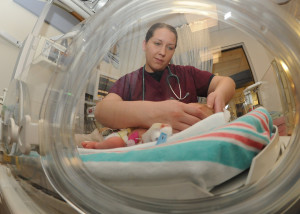August is observed as National Immunization Awareness Month and is a time to highlight the extreme importance and value of vaccination for people of all ages. Vaccination serves as one of the best ways to protect infants, children, and adolescents from sixteen potentially harmful, and even deadly, diseases. Although it is common to think of the vaccines against measles, pertussis, and polio, an astonishingly important vaccine since the end of the 20th century has targeted the bacteria, Haemophilus influenzae type b (Hib).
Haemophilus influenzae is a small, pleomorphic, gram negative coccobacillus. Some strains of H. influenzae possess a polysaccharide capsule, and these strains are serotyped into six different types (a-f) based on their biochemically different capsules.
The H. influenzae strains with no capsule are termed nonencapsulated H. influenzae or nontypable H. influenzae (NTHi). H. influenzae type b is the most virulent, with its polysaccharide capsule being the main factor. Antibody to the capsule is the primary contributor to serum bactericidal activity, and increasing levels of antibody are associated with decreasing risk of invasive H. influenzae disease.
H. influenzae type b most commonly causes pneumonia, bacteremia, meningitis, epiglottitis, and cellulitis. Non-type b encapsulated forms present in a similar manner to type b infections, while non typable strains more commonly cause infections of the respiratory tract, such as pneumonia, otitis media, sinusitis, and conjunctivitis.
Generally, the mode of transmission is person to person by inhalation of respiratory tract droplets or by direct contact with respiratory tract secretions. Pharyngeal colonization by H. influenzae is relatively common, especially with nontypable and non-type b capsular strains.
Before effective Hib conjugate vaccines for infants older than 2 months were available in 1990, Haemophilus influenzae type b was the leading cause of invasive bacterial disease among children in the United States.
One in 200 children developed invasive Hib disease by 5 years of age; approximately 60% of these children had meningitis and 3-6% died from the disease. Of the Hib meningitis survivors, many exhibited permanent sequelae ranging from mild hearing loss to mental retardation.
Sadly, I recall as a Pediatric resident admitting to the hospital at least one infant with H. influenzae type b meningitis almost every night when on call.Remarkably, since the introduction of Hib conjugate vaccines in the United States, the incidence of invasive Hib disease has decreased a stunning 99% to fewer than 1 case/100,000 children younger than 5 years of age, and in 2012, only 30 cases of invasive type b disease were reported in children under 5 years old.
Truly, it has been an amazing accomplishment. Nevertheless, the risk for invasive Hib disease persists among unimmunized and underimmunized children, highlighting the importance of full vaccination with the 2 or 3 injection (depending on the product) series between 2 and 6 months old and a single booster dose given between 12 and 15 months of age.
Certain additional doses may be indicated over 5 years of age depending on medical conditions, such as anatomic or functional asplenia, hematopoietic stem cell transplantation, or HIV infection. The Hib vaccine is very safe. The most common side effects are usually mild and consist of fever and rednesss, swelling, or warmth at the injection site. As with all current vaccines, significant advances and improvement in public health have been witnessed. It is incumbent upon each of us to maintain that success.


